Colostethus is a genus of poison dart frogs native to Central and South America, from Panama south to Colombia, Ecuador, and northern Peru. Their common name is rocket frogs, but this name may refer to frogs in other genera and families, following the taxonomic revision of the genus in 2006.
Aromobates, sometimes known as the skunk frogs, is a genus of frogs from the Andes of Venezuela and Colombia. Originally a monotypic genus consisting of the skunk frog, Aromobates nocturnus alone, it was later expanded to include Nephelobates. These frogs are difficult to differentiate from Allobates without using molecular markers.
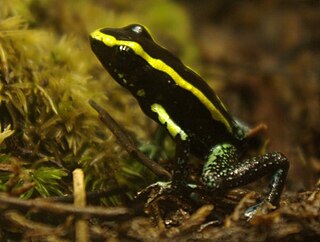
Phyllobates aurotaenia is a member of the frog family Dendrobatidae, which are found in the tropical environments of Central and South America. First described by zoologist George Albert Boulenger in 1913, P. aurotaenia is known for being the third most poisonous frog in the world. It is the smallest of the poison dart frogs in the Phyllobates genus and is endemic to the Pacific coast of Colombia.
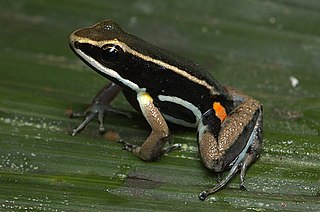
The Aromobatidae are a family of frogs native to Central and South America. They are sometimes referred to as cryptic forest frogs or cryptic poison frogs. They are the sister taxon of the Dendrobatidae, the poison dart frogs, but are not as toxic as most dendrobatids are.

Andinobates altobueyensis is a species of frog in the family Dendrobatidae. It is endemic to Alto del Buey mountain in the Serranía del Baudó range, in the Chocó Department of western Colombia. Its common names include Alto de Buey poison frog, golden poison-arrow frog, and golden poison frog.

The Brazil-nut poison frog is a species of frog in the family Dendrobatidae. It is endemic to the state of Pará in Brazil. The frog is believed to have received its common name from the fact that its tadpoles sometimes develop in the hard capsules of the Brazil nut tree, which are common in its range. The nuts fall to the forest floor where they are broken open by agoutis and other animals seeking the seeds, and empty husks fill with water.

Ranitomeya vanzolinii, also known as the Brazilian poison frog or spotted poison frog, is a species of frog from the family Dendrobatidae. It is found in the Amazonian rainforests of Brazil and Peru, and possibly Bolivia.
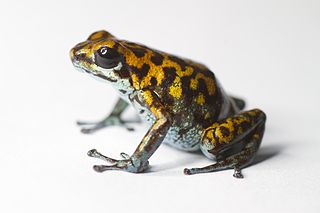
Vicente's poison frog is a species of frog in the family Dendrobatidae that is endemic to the Veraguas and Coclé Provinces of central Panama. It is a little known arboreal frog that inhabits humid tropical lowland and montane forest.

Andinobates virolinensis is a species of frog in the family Dendrobatidae. It is endemic to Colombia where it is confined to the Santander and Cundinamarca departments on the Cordillera Oriental.
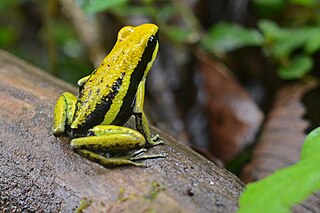
The pleasing poison frog is a species of frog in the family Dendrobatidae endemic to Peru.
The Cainarachi poison frog is a species of frogs in the family Dendrobatidae. It is endemic to Amazonian Peru and found in the lowlands adjacent to the northern end of the Eastern Andes. It was named after the Rio Cainarache Valley, where it was first discovered.

The Peru poison frog, also known as Peruvian poison frog, Peruvian poison-arrow frog and emerald poison frog, is a species of frog in the family Dendrobatidae. It is found in eastern Peru and western Brazil. Its natural habitats are primary premontane and subtropical or tropical moist lowland forests, rivers, freshwater marshes, and intermittent freshwater marshes.
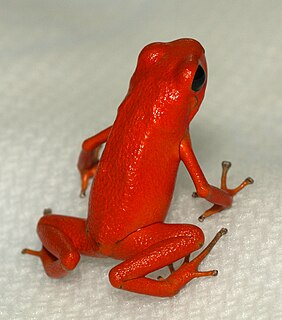
Oophaga is a genus of poison-dart frogs containing nine species, many of which were formerly placed in the genus Dendrobates. The frogs are distributed in Central and South America, from Nicaragua through the Colombian El Choco to northern Ecuador. Their habitats vary with some species being arboreal while other being terrestrial, but the common feature is that their tadpoles are obligate egg feeders.

Silverstoneia is a genus of poison dart frogs from southern Central America and northern South America, between southwestern Costa Rica and southwestern Colombia. It is named in honour of Phillip A. Silverstone, an expert on dendrobatoid frogs.

Hyloxalinae is a subfamily of frogs in the family Dendrobatidae.

Adelphobates is a small genus of poison dart frogs. They are found in the central and lower Amazon basin of Peru and Brazil, possibly Bolivia. It was originally erected as a sister group to the Dendrobates and Oophaga genera. The validity of the genus is still being discussed, with the alternative being "Dendrobates galactonotus group" within Dendrobates. One species originally placed in this genus as Adelphobates captivus has since been moved to the genus Excidobates erected in 2008.
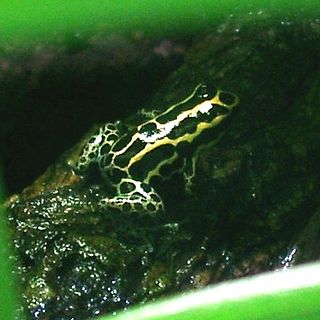
Ranitomeya is a genus of dart poison frogs found in Panama and South America south to Peru and Brazil, possibly into Bolivia.

Dendrobatinae is the main subfamily of frogs in the family Dendrobatidae, the poison dart frogs of Central and South America, found from Nicaragua to the Amazon Basin in Brazil.

Andinobates is a genus of poison dart frogs from Ecuador, Colombia and Panama. It contains species formerly classified in the genus Dendrobates and in 2006 transferred to the genus Ranitomeya. In 2011 Twomey, Brown, and their colleagues erected the genus Andinobates for a group of 12 species of Ranitomeya. Andinobates frogs can be distinguished from their sister taxon Ranitomeya anatomically in that their 2nd and 3rd vertebrae are fused. They show no limb reticulation, which is present in most species of Ranitomeya.
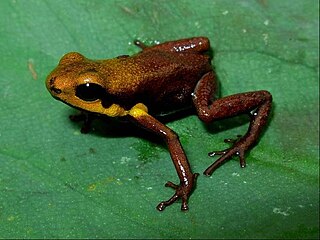
Andinobates tolimensis, the Tolimense poison frog, is a species of amphibian in the family Dendrobatidae, endemic to Colombia in the outskirts of Falan and north of the department of Tolima. Previously it was included in the genus Ranitomeya, but was reclassified in Andinobates, along with 11 other species. It is threatened by habitat loss. It is toxic to humans and when captured will excrete a milky substance.

















